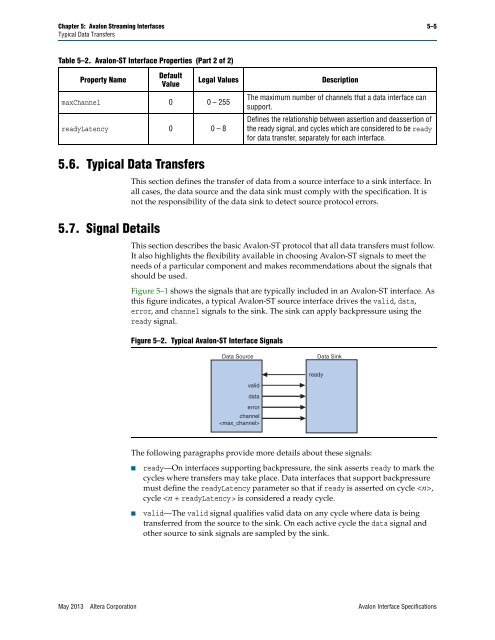Avalon Interface Specifications (PDF) - Altera
Avalon Interface Specifications (PDF) - Altera
Avalon Interface Specifications (PDF) - Altera
You also want an ePaper? Increase the reach of your titles
YUMPU automatically turns print PDFs into web optimized ePapers that Google loves.
Chapter 5: <strong>Avalon</strong> Streaming <strong>Interface</strong>s 5–5<br />
Typical Data Transfers<br />
Table 5–2. <strong>Avalon</strong>-ST <strong>Interface</strong> Properties (Part 2 of 2)<br />
Property Name<br />
5.6. Typical Data Transfers<br />
5.7. Signal Details<br />
Default<br />
Value<br />
maxChannel 0 0 – 255<br />
readyLatency 0 0 – 8<br />
Legal Values Description<br />
The maximum number of channels that a data interface can<br />
support.<br />
Defines the relationship between assertion and deassertion of<br />
the ready signal, and cycles which are considered to be ready<br />
for data transfer, separately for each interface.<br />
This section defines the transfer of data from a source interface to a sink interface. In<br />
all cases, the data source and the data sink must comply with the specification. It is<br />
not the responsibility of the data sink to detect source protocol errors.<br />
This section describes the basic <strong>Avalon</strong>-ST protocol that all data transfers must follow.<br />
It also highlights the flexibility available in choosing <strong>Avalon</strong>-ST signals to meet the<br />
needs of a particular component and makes recommendations about the signals that<br />
should be used.<br />
Figure 5–1 shows the signals that are typically included in an <strong>Avalon</strong>-ST interface. As<br />
this figure indicates, a typical <strong>Avalon</strong>-ST source interface drives the valid, data,<br />
error, and channel signals to the sink. The sink can apply backpressure using the<br />
ready signal.<br />
Figure 5–2. Typical <strong>Avalon</strong>-ST <strong>Interface</strong> Signals<br />
Data Source<br />
valid<br />
data<br />
error<br />
channel<br />
<br />
The following paragraphs provide more details about these signals:<br />
■ ready—On interfaces supporting backpressure, the sink asserts ready to mark the<br />
cycles where transfers may take place. Data interfaces that support backpressure<br />
must define the readyLatency parameter so that if ready is asserted on cycle ,<br />
cycle is considered a ready cycle.<br />
■ valid—The valid signal qualifies valid data on any cycle where data is being<br />
transferred from the source to the sink. On each active cycle the data signal and<br />
other source to sink signals are sampled by the sink.<br />
May 2013 <strong>Altera</strong> Corporation <strong>Avalon</strong> <strong>Interface</strong> <strong>Specifications</strong><br />
ready<br />
Data Sink
















